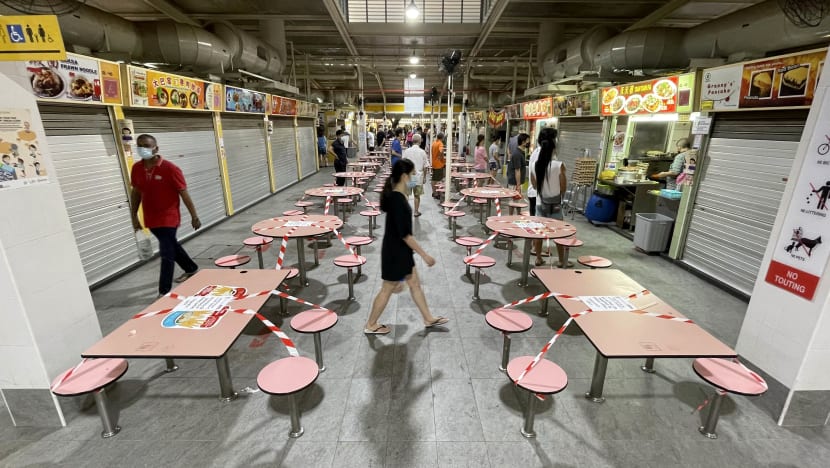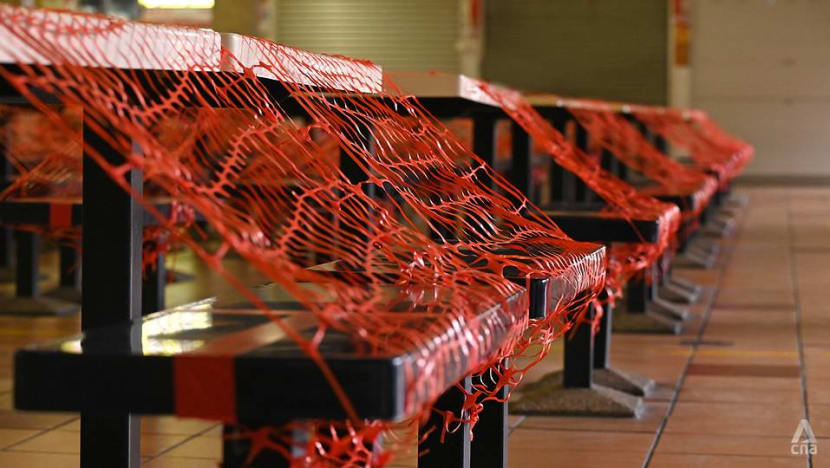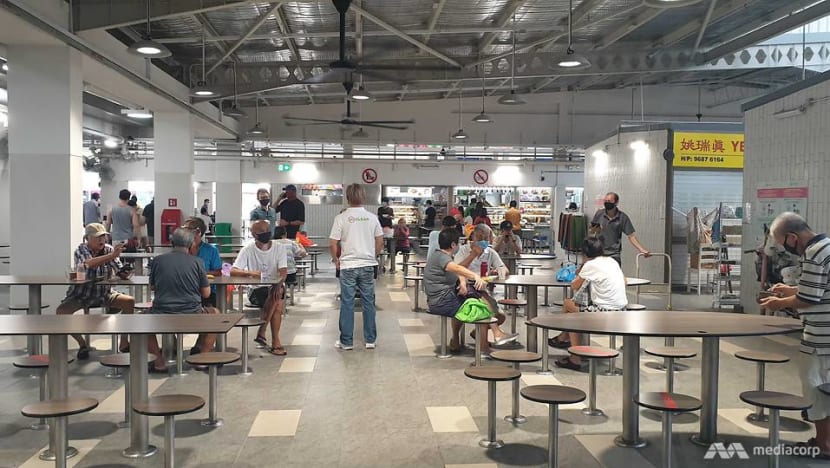58% of hawkers whose tenancies were up for renewal from April to June had rentals revised down

A customer with a takeaway meal at Chinatown Complex Food Centre, where tables and chairs are cordoned off to prevent people from dining during Phase 2 (Heightened Alert). (Photo: Gaya Chandramohan)
SINGAPORE: Of the 341 hawker stallholders whose tenancies were up for renewal between April and June this year, 58 per cent of them had their rentals revised down towards the market rate, said Senior Minister of State for Sustainability and the Environment Amy Khor on Tuesday (Jul 6).
The decrease for this group ranged from S$30 to more than S$2,500 per month, she said. Due to the COVID-19 pandemic, a "large majority" of hawker stalls saw their valuation decline in the 2021 financial year.
Rent increases for hawker stalls were frozen between April 2020 and March 2021, she noted.
Of those whose tenancies were up for renewal, 37 per cent continue to pay the same rental, and the remaining 5 per cent - or 17 of the 341 stallholders - saw their rent increase by S$10 to S$300, said Dr Khor.
For the 17 hawkers who saw an increase, the median rental was S$850. “And even the stalls which had rental increased by S$300 are still paying at or below the market valuation,” she added.
Dr Khor was responding to a parliamentary question from Mr Melvin Yong (PAP-Radin Mas) about financial aid for hawkers affected by a COVID-19 cluster, and how the Ministry of Sustainability and the Environment (MSE) intends to help draw crowds back to the affected markets and hawker centres once the cluster has closed.
WATCH: About 6,000 hawkers to get rental waivers to cope with COVID-19 measures
This comes after food blogger KF Seetoh said in a Facebook post that some hawkers' rents were raised "by almost 40 per cent".
In his post, he uploaded a photo of a notice sent by the National Environment Agency (NEA) to a hawker, detailing the rise in rent and renewal of the tenancy agreement.
“Here we all are doing our best to #supportourhawkers, and there they are at (the) same time raising the hawkers' rent by almost 40 per cent,” he wrote.
“Why oh why I ask. You may need to claw back to top up the national coffers but do your leaders even know it's a horrible timing to do so now. This hawker had been languishing in sales this whole year.”

A day after Mr Seetoh’s Facebook post, the NEA published a post on Facebook to “clarify” the situation.
“In recent years, rental revision upwards at tenancy renewals in our hawker centres have not exceeded S$300. On the other hand, there have been rental revisions downwards of more than S$300 upon tenancy renewals. It is misleading to look at percentage increases alone as a S$300 increase from a low rental will appear as a large percentage increase,” said the agency.
"NO MINIMUM RENTAL"
The median monthly stall rental of non-subsidised cooked food stalls across all hawker centres is S$1,250, which is “significantly lower” than those at commercially-operated coffee shops and food courts, said Dr Khor on Tuesday.
“When new hawkers obtain vacant stalls in NEA-managed hawker centres via monthly stall tenders, the rent that they pay is the amount they tendered. There is no minimum rental,” said Dr Khor, adding that some successful bidders tender high bids to secure a choice stall at their preferred locations.
“This open tender system ensures transparency and fair pricing, particularly for stalls in high demand, such as those in locations with high footfall."
These rentals are kept unchanged for the duration of the three-year tenancy period, she added.
“When the tenancy expires, we do not put up the occupied stalls for tender as this would be disruptive to hawkers who have built their business and customer base," said Dr Khor.
"Instead, rentals are adjusted based on independent professional valuation that considers factors such as the footfall of the centre, stall size, and prevailing market conditions to assess the market rental.”
When dining in was first suspended during the “circuit breaker” period last year, hawkers’ businesses were hit, said Dr Khor.
“This continued even when dine-in resumed subsequently, due to the implementation of group size restrictions and default working from home arrangements,” she added.

The Government provided five months of rental waiver and three months of subsidies in 2020 for table cleaning and centralised dishwashing fees to help hawkers defray operating costs, said Dr Khor.
When restrictions on dining in were imposed again from May 16 to July this year, the Government also provided two months of rental waiver and subsidy for cleaning services, she added.
Eligible hawkers also received S$9,000 in financial support in 2020 through the Self-Employed Person Income Relief Scheme, she added.
"A CHALLENGING PERIOD"
"We are mindful that however small the group, any rental increase, even if it has been moderated, is always sensitive, and that this is a challenging period," said Dr Khor.
Hawkers who continue to face financial difficulties because of the increase after the most recent two-month rental waiver from mid-May to mid-July can approach NEA for assistance. NEA will do "a careful review on a case-by-case basis", she added.
“These measures have in sum contributed to helping our hawkers sustain their livelihoods during a difficult period,” said Dr Khor.
Occupancy rates for cooked food stalls in NEA-managed centres have “remained high” at about 97 per cent, she told Parliament.

A monthly average of 16 stall tenancies were terminated from 2020 to May 2021, lower than the monthly average of 28 terminations per month from 2017 to 2019.
The Government is looking into providing rental waivers for hawkers affected by closures as a result of COVID-19 clusters, she added.
“In the case of the Bukit Merah View Market and Food Centre, hawkers operating there are already covered under the current rental waivers until mid-July,” said Dr Khor.
Hawkers who have been served quarantine orders can seek more support from various financial schemes like the Quarantine Order Allowance Scheme or the COVID-19 Recovery Grant, she added.
“For hawker centres impacted by COVID-19 clusters, it is crucial to regain public confidence and assure returning customers that there are no compromises to cleanliness and hygiene standards,” said Dr Khor.
“NEA has been working with stakeholders, such as cleaning companies and town councils to ensure proper deep cleaning and disinfection of common areas, and the adoption of robust workflows to clean and sanitise tables. And we will continue to do so.”












